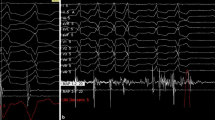Summary
In the majority of cases, atrial fibrillation seems to depend on multiple, simultaneously active reentrant circuits. Their pathlength is defined by local refractory periods and conduction velocities. Active circuits experience constant changes in number, location and dimension. Ablative interventions targeting individual circuits are, therefore, not likely to be successful. Current approaches aim at multiple, electrically isolated atrial segments providing insufficient space for the given minimal size of potential reentrant circuits. Pharmacologic interventions either result in conduction delay and subsequent conduction block, or in prolongation of local refractoriness increasing the size of existing circuits. Creation of isolated atrial segments by endocardial catheter ablation implies the feasibility of extended, contiguous transmural lesions. Mapping studies in healthy dogs demonstrated that contiguous anatomic lesions are very hard to achieve with conventional catheter techniques. Functional conduction blocks, however, may be obtained. Furthermore, application of radiofrequency energy induced prolongation of local refractoriness even at a distance from the actual anatomic lesion. Thus, in the interventional therapy of atrial fibrillation, functional effects of radiofrequency ablation might at least serve to facilitate the strenuous implementation of the isolation concept.
Zusammenfassung
Vorhofflimmern scheint meist auf multiplen, simultan aktiven Erregungskreisen zu beruhen. Deren Kreisbahnlänge definiert sich aus lokaler Refraktärzeit und Leitungsgeschwindigkeit. Anzahl, Lokalisation und Dimension aktiver Erregungskreise wechseln ständig. Spezifische, auf einzelne Kreisbahnen gerichtete Ablationsversuche sind daher nicht aussichtsreich. Gängige Therapiekonzepte streben multiple, elektrisch isolierte Vorhofsegmente an, die ungenügend Raum für die definierte Mindestgröße potentieller Erregungskreise bieten. Pharmakologische Therapiemaßnahmen bewirken entweder eine Leitungsverzögerung bis hin zur kompletten Leitungsunterbrechung oder eine Verlängerung lokaler Refraktärzeiten und damit eine Steigerung des Raumbedarfs bestehender Erregungskreise. Die Schaffung isolierter Vorhofsegmente mittels endokardialer Katheterablation setzt die Machbarkeit langstreckiger, kontinuierlicher, transmuraler Läsionen voraus. In Mapping-Untersuchungen an gesunden Hunden konnte gezeigt werden, daß kontinuierliche langstreckige anatomische Läsionen mit konventioneller Kathetertechnik kaum zu erzielen sind, wohl aber funktionelle Leitungsblockierungen. Weiterhin führt Radiofrequenzapplikation zu einer Verlängerung lokaler Refraktärperioden weit über die eigentliche anatomische Läsion hinaus. Neben dem nur schwer umzusetzenden Isolationsprinzip könnten solche funktionellen Radiofrequenzeffekte daher auch ein zumindest additives Therapiekonzept bei der interventionellen Behandlung von Vorhofflimmern darstellen.
Similar content being viewed by others
Author information
Authors and Affiliations
Rights and permissions
About this article
Cite this article
Schoels, W., Becker, R. Experimentelle Befunde der Katheterablation supraventrikulärer Tachyarrhythmien. Z Kardiol 89 (Suppl 3), 87–92 (2000). https://doi.org/10.1007/PL00022876
Issue Date:
DOI: https://doi.org/10.1007/PL00022876




